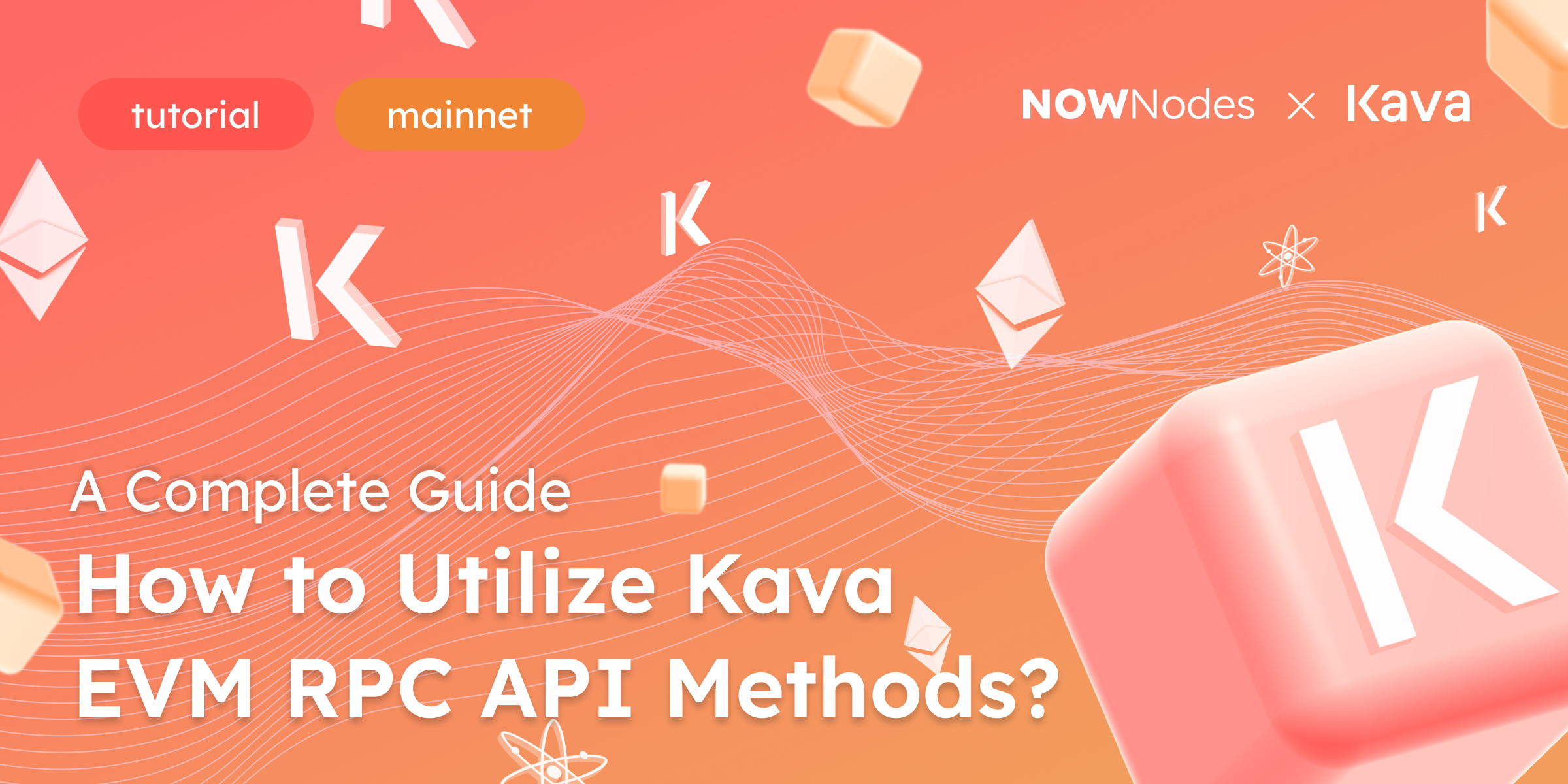Being EVM-compatible while born on the combination of Cosmos SDK and Tendermint Consensus, the Kava network has emerged as a significant player in the blockchain market, offering unique opportunities for developers and users alike. As the blockchain industry continues to evolve, the demand for interoperability and scalability solutions will grow rapidly. It opens great opportunities for Solidity developers who choose Kava as the platform to build dApps on, as they can benefit from the scalability and security of the Kava Network while sticking to the familiar development process.
In this guide, we’ll delve into the Kava network, introduce the Kava EVM, and provide a comprehensive walkthrough on the process of accessing and utilizing Kava EVM RPC methods with the help of NOWNodes. Keep reading to unlock the full potential of the Kava blockchain.
What is Kava Network?
Kava is a decentralized blockchain that combines the speed and interoperability of Cosmos with the developer power of Ethereum.
The Kava network is a groundbreaking blockchain platform designed to power a wide array of DeFi applications and services. Built on the Cosmos SDK, it leverages the interoperability and scalability of the Cosmos ecosystem, known as the “Internet of Blockchains.” Moreover, the Kava Network provides an EVM-compatible execution environment that empowers Solidity developers and their dApps to benefit from scalability and security.
Kava uses the Tendermint consensus mechanism, renowned for its robustness and reliability. With single-block finality and supreme scalability, Tendermint Consensus allows Kava to keep the transaction needs of thousands of protocols and millions of users.
The Kava Networks also has its native token KAVA. This token is integral to the security, governance, and mechanical functions of the platform. There are three main use cases for the KAVA token:
- Security
- The Kava Blockchain employs Proof-of-Stake (PoS) validation, where nodes in the network, referred to as “validators”, are selected based on the number of KAVA tokens they stake.
- Governance
- KAVA is used for proposals and voting on critical parameters of the Kava Network. KAVA token holders help fuel growth on the network by staking their KAVA to vote on KavaDAO proposals that control the network’s resources
- Incentives
- A portion of KAVA emissions is distributed as incentives for scaling the network. These incentives go directly to top projects on each chain to drive growth, encourage competition, and improve the health of the Kava ecosystem.
What is the Co-Chain Architecture of the Kava Network?
The combination of Ethereum EVM and Cosmos SDK is what makes Kava Network different from other blockchains. This strategic alliance lets developers familiar with Solidity migrate their Ethereum-based applications to the Kava network, profiting from improved efficiency, security, and the extensive benefits of the Cosmos ecosystem.
All that was made possible due to the robust Co-Chain Architecture and The Translator Module. KAVA’s co-chain architecture enables developers to build and deploy their applications and smart contracts using either the EVM or Cosmos SDK execution environments with seamless interoperability between the two.
The Kava Network Co-Chain Architecture consists of two main components: the Ethereum Co-Chain and the Cosmos Co-Chain. The Ethereum Co-Chain part is responsible for building dApps and smart contracts. It allows developers to deploy Ethereum-based applications and smart contracts directly on Kava without any modifications. While the Cosmos Co-Chain part is aimed at cross-chain communications. It is perfectly suitable for building high-performance, interoperable applications and enables Kava to connect with other blockchains within the Cosmos network through the IBC (Inter-Blockchain Communication) protocol, promoting cross-chain asset transfers and communication. Both parts of the Architecture are connected by the Translator Module. It acts as a bridge, translating and transferring information between the two co-chains, which have different data structures, consensus mechanisms, and transaction formats.
What is Kava EVM? Introduction to Kava EVM
At the heart of Kava’s expansion into the Ethereum ecosystem is the Kava EVM – an Ethereum Virtual Machine implementation that facilitates the deployment and execution of Ethereum-compatible smart contracts on the Kava network. This compatibility layer bridges the gap between the Cosmos and Ethereum communities, allowing developers to leverage Ethereum’s rich development tools and languages, such as Solidity, within the scalable and interoperable Kava ecosystem. This Ethereum compatibility provides huge benefits for developers who are familiar with building on Ethereum, as Kava EVM utilizes the same JSON RPC methods to interact with the node.
Ethereum’s compatibility on Kava EVM significantly lowers the entry barrier for Ethereum developers, enabling them to leverage their existing codebases and expertise in a new environment. It’s like moving to new apartments with the old furniture, but even much easier, because all your needed stuff is already waiting for you there.
There are many benefits and exciting features that Kava EVM offers for Web3 developers. Some of the most common key features are:
- Velocity and Efficiency: With a block mining time of just 6 seconds and finality achieved in just one block, the Kava EVM offers quick and effective transaction execution.
- Safeness and Scalability: Anchored by Kava’s Tendermint consensus mechanism, the infrastructure is both robust and capable of scaling, housing a broad spectrum of dApps and significant volumes of transactions.
- Interoperability and Integration with the Cosmos Ecosystem: Being a part of the Cosmos ecosystem, Kava EVM benefits from the seamless interoperability provided by the Cosmos SDK. For Web3 developers, this interoperability opens up a multitude of possibilities for cross-chain applications and services, enabling them to tap into liquidity, users, and functionalities across multiple blockchain ecosystems.
- Economic and Operational Efficiencies: Transaction costs on the Kava EVM can be more predictable and often lower than those on Ethereum’s mainnet, particularly during periods of network congestion.
Kava EVM effectively blends the powers of Ethereum with the outstanding advantages of the Cosmos SDK and the Kava network, forming an adaptable and effective Web3 platform for dApp development.

How to Access Kava RPC Full Nodes via NOWNodes
Accessing Kava’s capabilities requires interaction with its full nodes, and NOWNodes offers an affordable and the most effective way to do it. NOWNodes provides a reliable, secure, and fast connection to Kava RPC full nodes, simplifying the process for developers and users. With Kava Full Node, you can enjoy seamless integration of Kava within your crypto project, power your infrastructure, and get done with node maintenance in less than one hour.
NOWNodes is a blockchain-as-a-service solution that lets users get access to full Nodes and blockbook Explorers via API. The service provides a high-quality infrastructure that is quick, cost-effective, and reliable. You can explore our Service Quality Standards to find out about our unique features and competitive advantages.
For Web3 developers willing to build on Kava benefiting from both Ethereum and Cosmos features available on this network, and expanding its ecosystem, NOWNodes provide no rate-limit access to Kava RPC, Kava EVM, and Tendermint nodes. This is a full pack for enterprises and builders that require on-chain data to process KAVA transactions and deploy smart contracts.
By choosing NOWNodes for your Kava Full Node development needs, you will receive unparalleled reliability, guaranteed uptime, and 24/7 professional support, allowing you to focus on what matters most: building innovative dApps and blockchain solutions.
Accessing Kava RPC, Kava EVM, and Tendermint nodes has never been as easy as with NOWNodes. All you need to do is to follow these simple steps:
- Visit the NOWNodes website (https://nownodes.io/) and create a profile. You will need to verify it with your email.
- Then choose a tariff plan. There are different plans that fit any Web3 development needs. Whether you’re a beginner, there’s a START FREE plan for you, or you’re an Enterprise owner – we have an ENTERPRISE plan, offering 100 MILLION requests/month
- The next step is to choose the desired blockchains to access. By utilizing a START plan you will be provided with the option to choose only 5 blockchain networks. If you are looking for the Kava mainnet, don’t forget to include it in the list.
- On the “DASHBOARD” page find the “ADD API KEY” button. Here, you can generate a Kava API key.
- Finally, when the registration process is complete use the ETH methods on the “DOCS” page to interact with the Kava network through the EVM node.
- Use the provided Kava EVM endpoint
kava-evm.nownodes.ioto send requests to the node.
If you are about to work with the Kava Tendermint node interface, keep in mind that it is only available in the PRO plan and higher.
How to Interact With Kava EVM Node Using JSON RPC Methods
Interacting with the Kava EVM node involves utilizing JSON RPC methods, a standard protocol for invoking functions on a remote server. Here’s how to get started:
- Choose Your Tool: Decide on a tool for sending JSON-RPC requests, such as cURL for command-line interfaces, Postman for a graphical interface, or Web3.js/Ethers.js for integration into JavaScript applications.
- Formulate Your Request: Construct a JSON object specifying the
jsonrpcversion (usually “2.0”), themethodyou wish to call, any necessaryparams, and of course, don’t forget your<api-key>to authenticate your access to the node, and a providedkava-evm.nownodes.ioendpoint to interact with the Kava EVM node. - Send the Request: Use your chosen tool to send the request to the Kava EVM node endpoint.
- Handle the Response: Process the JSON response from the node, which contains the result of your RPC call. This could be information like the latest block number, the balance of an account, or the receipt of a submitted transaction.
There are a variety of ETH JSON RPC methods available to interact with the Kava EVM node. Now let’s take a look at some of the basic methods of EVM like eth_blockNumber, which returns the current latest block number. Here’s the sample request:
curl --request POST \
--url https://kava-evm.nownodes.io/<api-key> \
--header 'Content-Type: application/json' \
--data '{
"jsonrpc": "2.0",
"method": "eth_blockNumber",
"params": [],
"id": 1
}' So, the response will show the latest mined block in the Kava blockchain in hexadecimal numbers, and it might be:
{
"jsonrpc": "2.0",
"id": 1,
"result": "0x87abdf"
}In this example, the latest block is 8891359th. Moreover, this method could be used to check if your connection to the node is correct. If the latest block that you see is up-to-date, then you’re fine and can start sending more complex requests.
Now let’s check another classical Ethereum JSON-RPC API method eth_getBlockByHash that can be utilized on Kava EVM for querying sophisticated information about a specific block by its given hash. Here’s the sample request:
curl --request POST \
--url https://kava-evm.nownodes.io/<api-key> \
--header 'Content-Type: application/json' \
--data '{
"jsonrpc": "2.0",
"method": "eth_getBlockByHash",
"params": [ "0x53a5e82253d2179241d1bff69c37be423f52902c459b5c5ee41280098bb80850",
false
],
"id": 1
}'This method provides detailed data about a specific block identified by its hash. It includes the maximum amount of gas that could have been used by the transactions in the block, the total amount of used gas, the address of the validator who mined the block, the block number in hexadecimal, the timestamp when the block was mined, the array of transactions included in the block and more. Here’s the sample response for the hash provided in the example:
{
"jsonrpc": "2.0",
"id": 1,
"result": {
"difficulty": "0x0",
"extraData": "0x",
"gasLimit": "0x1312d00",
"gasUsed": "0x2f26a",
"hash": "0x53a5e82253d2179241d1bff69c37be423f52902c459b5c5ee41280098bb80850",
"logsBloom": "0x00000000000000000000000000000000000000000000000000000000000000000000000000000000000000000000000000000000000000000000000000000000000000000000000000000000000000000000000000000000000000000000000000000000000000000000000000000000000000000000000000000000000000000000000000000000000000000000000000000000000000000000000000000000000000000000000000000000000000000000000000000000000000000000000000000000000000000000000000000000000000000000000000000000000000000000000000000000000000000000000000000000000000000000000000000000",
"miner": "0x0000000000000000000000000000000000000000",
"mixHash": "0x0000000000000000000000000000000000000000000000000000000000000000",
"nonce": "0x0000000000000000",
"number": "0x7fe39e",
"parentHash": "0x6e84882e49ebfe8027472e223149211f2b37a9647a188c6069a52801be1aaa07",
"receiptsRoot": "0x56e81f171bcc55a6ff8345e692c0f86e5b48e01b996cadc001622fb5e363b421",
"sha3Uncles": "0x1dcc4de8dec75d7aab85b567b6ccd41ad312451b948a7413f0a142fd40d49347",
"size": "0x2c5f",
"stateRoot": "0x5f1b0f3aa506a5c2b072e823abba46685faa798af8559362e6441bdd70150d2f",
"timestamp": "0x65b96d7f",
"totalDifficulty": "0x0",
"transactions": [],
"transactionsRoot": "0x56e81f171bcc55a6ff8345e692c0f86e5b48e01b996cadc001622fb5e363b421",
"uncles": []
}
}This method could also be used for checking the amount of stored blocks. NOWNodes’ Kava EVM is a pruned node, not an Archive one. It stores a limited amount of blocks, however, if your development needs are much more than that, we are open to offer you a custom DEDICATED tariff plan, which could involve the Kava archive RPC full node, block explorer, and much more. Feel free to contact our sales team through our Telegram Community any time and day.
Now, we have shown you how to interact with the Kava EVM Node using JSON RPC methods in the simplest examples. You can explore all the ETH methods available deeper by visiting the NOWNodes Official Documentation or the Ethereum JSON-RPC API documentation.
Conclusion
The Kava network and its EVM layer present a solid platform for DeFi innovation, combining the robust features of the Cosmos SDK with Ethereum’s widespread adoption and developers-friendly ecosystem. By utilizing Kava EVM RPC methods, developers can unlock the network’s full potential, creating applications that leverage the best of both worlds. Whether you’re an experienced Ethereum developer looking to explore new horizons or a Cosmos enthusiast willing to tap into Ethereum’s capabilities, Kava EVM offers a bridge to a more interconnected and versatile blockchain future.
Here at NOWNodes, we’re always curious about our customers’ opinions. That’s why we are begging you to leave your feedback in the comments in our Telegram Builders Community or just by hitting our DMs at X/Twitter.
Let’s Lead The World To Web3 with the Kava Network #NOW



